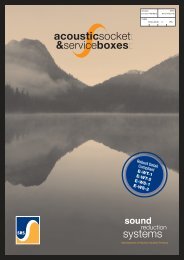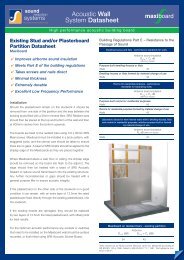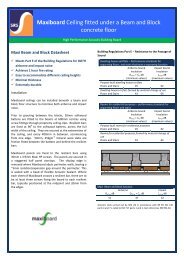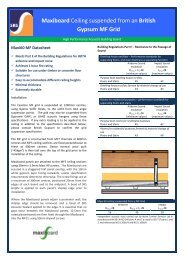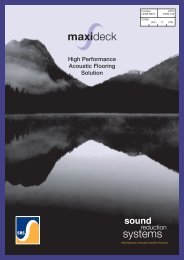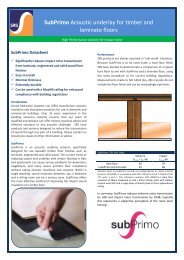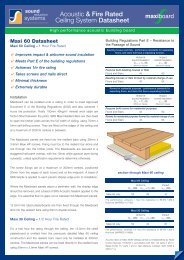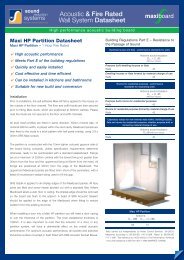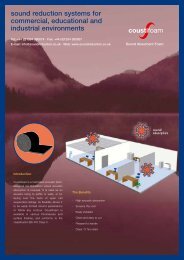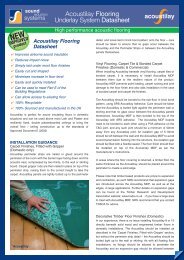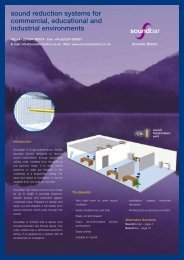Acoustic Damping for Metal Profile Ceilings BB93 Solution HTM 08 01 Solution
Raincheck Brochure - Sound Reduction Systems Ltd.
Raincheck Brochure - Sound Reduction Systems Ltd.
Create successful ePaper yourself
Turn your PDF publications into a flip-book with our unique Google optimized e-Paper software.
<strong>Acoustic</strong> <strong>Damping</strong> <strong>for</strong><br />
<strong>Metal</strong> <strong>Profile</strong> <strong>Ceilings</strong><br />
<strong>BB93</strong> <strong>Solution</strong><br />
<strong>HTM</strong> <strong>08</strong> <strong>01</strong> <strong>Solution</strong>
Introduction<br />
Benefits<br />
✔<br />
✔<br />
✔<br />
✔<br />
✔<br />
✔<br />
✔<br />
✔<br />
✔<br />
✔<br />
<strong>BB93</strong> <strong>Solution</strong> to rain noise in schools<br />
<strong>HTM</strong> <strong>08</strong> <strong>01</strong> <strong>Solution</strong> to rain noise in<br />
healthcare buildings<br />
Improves learning and working conditions<br />
Reduces rain noise through all metal<br />
profile roofs<br />
Manufactured in association with<br />
Technology<br />
Supplied in self adhesive rolls and strips<br />
Extremely high per<strong>for</strong>mance<br />
Ideal <strong>for</strong> both New Build and<br />
Retro-fit installations<br />
Tested to BS EN ISO 140-18<br />
Only 1mm thick<br />
Introduction<br />
<strong>Acoustic</strong> innovators, Sound Reduction Systems Ltd, in<br />
association with DEDPAN Technology, have developed<br />
the perfect acoustic damping material to reduce the<br />
noise generated by rain falling on metal profiled roofing<br />
systems.<br />
Rain falling on these types of roofs causes a nuisance<br />
in many different environments, ranging from<br />
commercial offices to industrial factory units. The<br />
problem has been highlighted in the <strong>BB93</strong> design guide<br />
on acoustics within schools. Referring specifically to the<br />
issue mentioned above, the guidance of <strong>BB93</strong> is to<br />
provide ‘damping of the profiled cladding (e.g. using<br />
commercial damping materials)’.<br />
The problem of rain noise on profiled metal roofing<br />
systems is a well documented one, yet a test procedure<br />
to measure rain noise in the laboratory was only officially<br />
published in 2006. BS EN ISO 140-18 outlines a<br />
method of simulating rainfall under ideal conditions,<br />
using a water tank with a per<strong>for</strong>ated base suspended<br />
above the test specimen, with a receiver room below.<br />
The application of Raincheck provides significant<br />
improvements to the overall roofing system under these<br />
test conditions.<br />
SRS Raincheck is the perfect solution to the issue of<br />
rain noise in commercial, industrial and educational<br />
environments. Should you require further details, or to<br />
discuss your particular application in greater detail,<br />
please feel free to contact our industry leading<br />
technical team on <strong>01</strong>204 380074 or email<br />
info@soundreduction.co.uk<br />
A Raincheck demo is available to view on our You Tube<br />
Channel: www.youtube.com/soundreduction<br />
2
Installation<br />
Installation<br />
• Prior to installation, it is essential that the surface to be<br />
treated with Raincheck is clean and dry.<br />
• Raincheck is quickly and easily<br />
installed on the metal profiled<br />
sections. Simply remove a<br />
section of the backing paper<br />
and adhere the Raincheck strip<br />
to the metal profile. The lightweight, flexible material will<br />
easily mould to the contours of the roofing system.<br />
• Work your way along the profile<br />
in small stages, removing small<br />
sections of the backing paper<br />
and compressing the rain check<br />
material to the profile as you go.<br />
Ensure that there are no air pockets in the material. If an<br />
air pocket develops, you can burst the pocket with a<br />
trimming knife and press the material back down.<br />
<strong>Acoustic</strong> Per<strong>for</strong>mance:<br />
Plots of Sound Intensity Level<br />
BS EN ISO 140-18:2006 outlines a method of simulating rainfall<br />
under laboratory conditions using a water tank with a per<strong>for</strong>ated<br />
base, suspended above a test specimen.<br />
Measurements are taken below the specimen within the receiving<br />
room to assess the sound intensity level re 10 -12 W/m 2 (dB). The lower<br />
the sound intensity level within the receiver room, the greater the<br />
effect of the damping material.<br />
In the acoustic tests below, measurements of sound intensity <strong>for</strong><br />
each type of rain condition were made directly in accordance with<br />
BS EN ISO 15186-1:1997 and BS EN ISO 140-18:2006.<br />
Test subject : (3.7m 2 ) 5no 400 x 2102mm, 0.9mm gauge,<br />
3.5kg/m 2 , ribbed aluminium standing seam roof with stucco<br />
emboss installed at a pitch of 7° below the water tank. Test<br />
Reference: WS219329<br />
Heavy Rainfall - Simulated conditions <strong>for</strong> rainfall that<br />
occurs every 50 years<br />
• Moderate hand pressure should<br />
be fine to achieve a good bond,<br />
however, if a stronger bond is<br />
required, a hand roller can be<br />
used to ensure a more even<br />
application of pressure across the surface of the Raincheck.<br />
Moderate Rainfall - Simulated conditions of rainfall that<br />
occurs every 2 years<br />
• For the best results, SRS recommend that a surface area<br />
equivalent to 60% of the total roof size is treated with the<br />
Raincheck product, using an even distribution of the<br />
material across the space.<br />
PHYSICAL PROPERTIES:<br />
Colour: Green<br />
Adhesive Type: Acrylic P.S<br />
Weight: 1.90Kg/m 2<br />
Flexibility (bent around a 30mm mandrel): Flexible to 5 o C<br />
Thickness: 1.0mm<br />
Maximum Temperature Tolerance: 190 o C (short exposures)<br />
Flammability: Pass FMVSS 302<br />
Structure<br />
A-Weighted Sound Intensity Level L iA (dB)<br />
“Heavy” Rain “Moderate” Rain<br />
Untreated Roof 70.6 54.1<br />
Roof with 164mm Raincheck/40% roof coverage 66.0 49.4<br />
Roof with 246mm Raincheck/60% roof coverage 64.3 48.1<br />
3
The SRS Raincheck Challenge<br />
1 Hold a tin can by the ring pull at the top and use a hard object,<br />
such as an item of metal cutlery or a metal pen to strike the can.<br />
You will clearly be able to hear the ‘tinny’ sound of the can<br />
resonating in the room.<br />
2 Remove the backing paper and apply the<br />
‘Raincheck’ strip around the middle of the can.<br />
3 Striking the can with only a very small percentage of total surface<br />
area treated with ‘Raincheck’ produces an extremely different<br />
effect. The damping effect of ‘Raincheck’ dramatically reduces the<br />
vibration of the can, producing a very dull thud.<br />
Sound Reduction Systems Ltd<br />
Adam St, Off Lever St, Bolton BL3 2AP<br />
Tel: +44 (0)1204 380074 · Fax: +44 (0)1204 380957<br />
E-mail: info@soundreduction.co.uk · Web: www.soundreduction.co.uk<br />
Site conditions and installation standards vary. SRS cannot take responsibility <strong>for</strong> the per<strong>for</strong>mance of any installed system of which SRS products are only a part, or that have been<br />
installed incorrectly. Prior to installation, it is necessary to identify and eliminate possible flanking paths that may compromise the acoustic per<strong>for</strong>mance of any SRS product.



